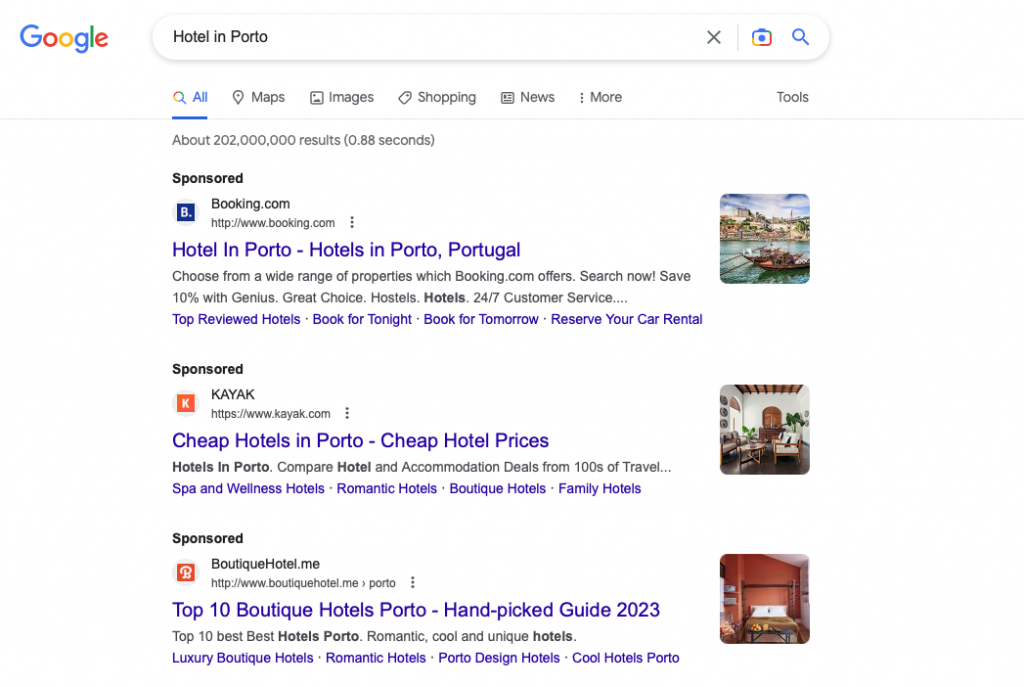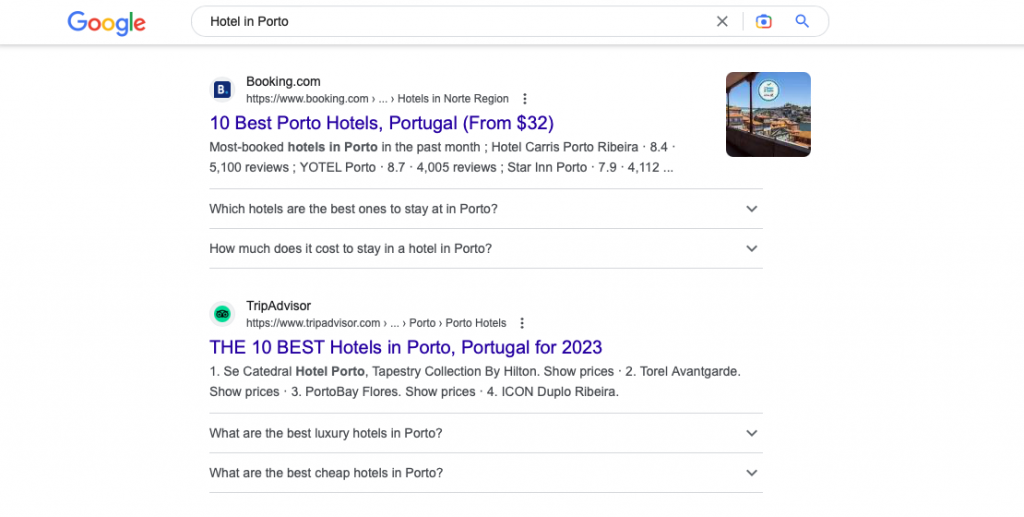Answer honestly. How many times have you Googled something and you went to the second page of results?
2 times? 4 times?
The reality is that only 0.63% of users go to the second page of search results (Backlinko).
In other words, 99.37% of traffic stays on the first page, and a whopping 75% of the clicks are made on the first 3 organic results.
This is the importance of SEO.
When it comes to online presence, every business aspires to one thing: To appear in the first position on the search engine results page.
It is normal to feel a little confused about what steps you should take to achieve this goal.
For this, we decided to create a comprehensive guide for beginners on what you need to understand to get started.
In this article you will find:
What is SEO
SEO is the process of optimizing a website, blog or webpage so that it can be found more easily by search engines such as Google or Bing.
For every search made, Google organizes the results to show you the most relevant ones. And what determines the relevance of these results are a number of factors, which the practice of SEO incorporates.
Before you look at the factors Google considers to position your page at the top of the search results, there are a few terms you need to know.
The Basics of SEO
Search Engines
The job of search engines is to create a hierarchy of results, ordered from most relevant to least relevant, according to what you are looking for.
To be able to sort the results, Google uses “crawlers”, which are bots that go through all the content on the web and read all the information on a website.
After being read, the information is indexed, which means that it is stored in a kind of digital library).
After this, the last step is to sort the information according to a series of SEO factors such as keywords, links, speed of the website, quality of the content, and others that we will see below.
SERP
When the sorting is done, Google presents it in a compact form on a SERP.
The SERP (Search Engine Results Page) is the search engine results page, which shows you the results of what you searched for.
Normally, the SERP has a structure where it shows the paid results first, and then the organic (unpaid) results.
Here is a practical example.
When you search for “Hotel in Porto”, Google will show you paid results, identified as sponsored, on the SERP first.

However, if you keep scrolling, the organic search results will appear, without any identifiers whatsoever. These are the results you can “influence” through SEO.

SEO Ranking Factors
There are two main categories into which SEO factors fall into.
On-Page SEO
On-Page SEO refers to practices that are performed internally. Given this, it is the type of SEO that you can have the most control over.
As we saw above, crawlers will go through the entire content of your web page looking for:
1. Keywords
Keywords are words added to your content that make it easier for them to discover it.
To find keywords relevant to your audience you can use several tools such as Ahrefs, SemRush, WordStream or Google’s own tool, Google Keyword Planner.
Also about keywords, it is important not to overdo it in the amount and frequency you insert them in your texts. There is a consensus among SEO professionals that keywords should not appear more than once every 200 words.
2. Title Tags
Title tags are the first thing your readers see. These tags appear in the SERP and are a confirmed key factor in SEO rank.
Initially, some factors you need to pay attention to are:
- Keep the title between 50 to 60 characters in length.
- Insert a Keyword
- Keep it Simple
- Each page should have its own title
3. Meta descriptions
Right below the title comes the meta descriptions.
While this is no longer a factor that directly contributes to rankings, meta descriptions are still a great way to describe in an appealing way what your page is about.
This can positively impact your click-through rate, which will lead to a better position in the SERP.
Factors to consider in your meta description:
- Limit yourself to one or two sentences (150 to 165 characters).
Insert Call to Actions - Be clear about the contents of the page and what readers will gain by clicking
4. Internal links
This is the process of creating links to other pages on your own website. With these links you can redirect the readers of your website, to other articles that are relevant on the topic.
For example, if you are writing an article on Social Proof, you can direct them to the article by putting a link in the word itself, as we have done just now.
5. Website Speed and Optimization
The time it takes to open a page is very important when it comes to ranking in search engines.
Just to give you an idea, 53% of mobile visitors abandon the website if the page takes longer than 3 seconds to load.
Speaking of mobile, your website has to be optimized for mobile devices, as it is from here that on average, 58.43% of website traffic comes from mobile devices.
6. URL’s
The URL of your page is an important factor for SEO and consumer trust.
Your page URL should clearly identify what the page is about, as well as include the keyword, hyphens instead of spaces, Here is an example:
Bad URL: https://page-78355936/
Good URL: https://blog.swonkie.com/
7. Images
The images in your article should follow some important guidelines, such as
- Name and title: These elements should be inserted in the settings of the particular software you are using. In WordPress, for example, you should enter them in the image options, in the “alternative text” and “HTML title” respectively.
- Size: The size of images influences the loading time of your website. Make sure you use the correct dimensions.
8. Content
The heart of On-Page SEO is content. Ultimately content is the goal of the reader when searching for something.
However, it is important to know that Google’s algorithm does not read the content itself, but rather the structure in which it is written.
To have a good structure, pay attention to all factors mentioned above, as well as:
- Write articles with a minimum of 900 words and a maximum of 5000, this way the chances of getting indexed in the first places increase.
- Divide your text into small blocks, as this not only improves the readability of your article, but also improves SEO rankings.
Off-Page SEO
Off-Page SEO refers to all optimization strategies that occur outside of your website.
Although it does not occur within the web page, Off-Page SEO strategies aim to build authority and relevance, so that the audience outside your website perceives the value and content of your website.
Here are the strategies you can perform in Off-Page SEO.
1. Link building
In Google’s eyes, your website has more authority, the more links redirect to your website.
For this, you need to use Backlinks (external links that redirect to your website).
To get these links, you can do guest blogging, by writing articles on websites of references in your industry, experts and others.
This way, you not only build authority for your website, but you promote your content to other audiences.
2. Social Media
It is undeniable that social media is the main stage of the internet. And if you want as many people as possible to watch what you have to sell, then it is important that you use social media as an Off-Page SEO strategy.
Using this channel takes on more importance when you think that 75% of internet users, use social media to research products.
Since likes and shares don’t count for ranking, you have to channel the traffic from social networks to your website. For this, include links in your descriptions, bios and call to actions.
3. Influence Marketing
Closely linked with content marketing is Influencer Marketing, since influencers can’t live without content.
With influencer marketing you can market your product through a celebrity or influencer.
Usually these celebrities or influencers have a loyal fan base, or audience, which is an excellent opportunity to boost your product.
If you are interested in exploring influencer marketing (which by the way is the future of online sales), consider using a platform like Brinfer.
4. Reviews
This statistic from Trustpilot’s study tells you all about the importance of using reviews as an Off-Page SEO strategy:
85% of people read online reviews before making a purchase.
You can use a number of websites for this strategy, and you should evaluate the one that best fits your strategy and type of business.
Some platforms to do this can be: Trustpilot, TheFork (if you are a restaurant), G2 (for software), among others.
What’s Next?
With this beginner’s guide, you now understand what SEO is, how search engines and SERP results work, and what factors you need to pay attention to in your SEO strategy.
Now you just need to start applying it, but remember that SEO is a time-consuming process.
Only 5.7% of the pages studied by Ahrefs, ranked in the Top10 of search results, within 1 year for at least 1 keyword.
SEO is a marathon, not a sprint.
